|
Oracle® Business Intelligence Discoverer Configuration Guide
10g Release 2 (10.1.2.1) for Microsoft Windows and Solaris Operating System (SPARC) B13918-03 |
|
 Previous |
 Next |
|
Oracle® Business Intelligence Discoverer Configuration Guide
10g Release 2 (10.1.2.1) for Microsoft Windows and Solaris Operating System (SPARC) B13918-03 |
|
 Previous |
 Next |
Note: This chapter only applies to Discoverer Plus and Discoverer Viewer. For more information about configuring Discoverer Plus OLAP, see Chapter 6, "Configuring the Discoverer Catalog and Discoverer Plus OLAP".
This chapter explains how to start OracleBI Discoverer on a client browser machine in order to install and configure any required plug-ins (e.g. a Java runtime environment) or security certificates, and contains the following topics:
Section 3.1, "General information about starting OracleBI Discoverer"
Section 3.2, "What are the supported Web browser versions for Discoverer?"
Section 3.3, "About restricting how users can start Discoverer"
Section 3.6, "About running Discoverer Plus over HTTP for the first time on a client machine"
Notes
The instructions in this chapter assume that the Discoverer installation is associated with an OracleAS Infrastructure. If the Discoverer installation is not associated with an OracleAS Infrastructure, end users will not see the Discoverer connections page, and must enter login details directly using the Connect to OracleBI Discoverer - Connect Directly page.
Before users can use Discoverer to analyze relational data, the database must contain a Discoverer EUL Version 5.1.x.
You can use the checkdiscoverer utility to verify a Discoverer configuration and report on failures or anomalies (for more information about the checkdiscoverer utility, see Section D.2.2, "What is the checkdiscoverer utility?").
In some circumstances you might want to remove the Discoverer Plus applet from a client machine. For example, to provide a clean environment in which to run Discoverer Plus. To remove the Discoverer Plus applet from a client machine, do the following:
Display the JVM control panel (e.g. on a Windows machine, display the Control Panel, and double-click on the Java Plug-in icon).
Display the Cache tab.

Click Clear.
Alternatively, manually remove all files from the Oracle Jar Cache directory. For example, on Windows, remove all files from the C:\Documents and Settings\<Windows user name>\Oracle Jar Cache directory.
You might also need to clear the browser's temporary files (e.g. in Internet Explorer, choose Tools | Internet Options and click Delete Files).
In some circumstances you might want to remove the Java runtime environment plug-in from a client machine. To do this, remove all versions of the Java 2 Runtime Environment SE and Oracle JInititator from the client machine. For example, on Windows, display the Control Panel, then choose Add/Remove Programs.
You can upgrade the Java Plug-in on a browser machine without affecting the certified Java Plug-in version installed with Discoverer. For example, when you log in to Windows you might see a Sun Java Plug-in pop-up that informs you that a new version of the Java Plug-in is available for download by clicking Yes. If you click Yes to download and install the new version, Discoverer continues to use the Java Plug-in version installed when you first started Discoverer on that machine.
To start Discoverer Viewer, you just need an Internet browser, as follows:
To start Discoverer Viewer over HTTP, start an Internet browser and enter the Discoverer Viewer HTTP URL (e.g. http://<host.domain>:<HTTP port>/discoverer/viewer).
For more information, see Section 3.11, "How to start Discoverer Viewer over HTTP".
To start Discoverer Viewer over HTTPS, start an Internet browser and enter the Discoverer Viewer HTTPS URL (e.g. https://<host.domain>:<HTTPS port>/discoverer/viewer).
For more information, see Section 3.5, "About running Discoverer over HTTPS".
Depending on what software you have installed on your machine, you might also need the following:
If the client browser machine does not have a JVM installed, you need to install a JVM and initialize the Discoverer Plus applet for that machine. For more information, see Section 3.6, "About running Discoverer Plus over HTTP for the first time on a client machine".
To start Discoverer Plus over HTTPS, you must have installed a security certificate from a Certificate Authority. For more information, see Section 3.5, "About running Discoverer over HTTPS".
Notes
For information on finding out the default Discoverer port number, see Section 5.8, "How to list ports used by Oracle Application Server".
For information about supported Web browser versions for Discoverer, see Oracle Business Intelligence Installation Guide.
When running Discoverer Viewer with Internet Explorer 5.0, note the following:
There are known bugs in Internet Explorer 5.0 which can cause intermittent problems when posting information from Viewer form pages such as the parameter screen.
Internet Explorer versions prior to 5.5 have a variety of compatibility issues with certain versions of Microsoft Excel. For this reason, customers who use Internet Explorer and the "Export to Excel" feature in Discoverer Plus and Viewer are strongly recommended to use Internet Explorer 5.5 or higher.
Note: These problems are generic to Internet Explorer and Microsoft Excel and are not specific to their use with Oracle products.
In a secure Discoverer environment you want to enable only authorized end users to access Discoverer. For example, you might want to limit users to read-only access to Discoverer workbooks using Discoverer Plus.
Depending on your security requirements, you might do any of the following to provide a secure Discoverer environment:
You might run Discoverer Plus in read-only mode for specified Discoverer end users by removing the Create/Edit Query privilege in OracleBI Discoverer Administrator (for more information, see Oracle Business Intelligence Discoverer Administration Guide).
You might enable Oracle Advanced Security (formerly Advanced Security Option) encryption between the middle tier and the database.
For more information about other Discoverer security features, see Chapter 14, "Maintaining security with OracleBI Discoverer".
To start OracleBI Discoverer Plus, you require the following on the Discoverer Plus client machine (i.e. the browser machine):
administrative privileges on the client machine, because you need to be able to install a Java Virtual Machine
at least 50 MB of Users Personal Profile Space for the Oracle Jar Cache
a minimum of between 100 - 150 MB of available disk space to install a JVM
To start OracleBI Discoverer Viewer, you need only to be able to run a standard Web browser (e.g. Microsoft Internet Explorer) that has JavaScript and cookies enabled.
Before you can run Discoverer over HTTPS (i.e. in Secure Sockets Layer (SSL) mode), you must have installed a security certificate from a Certificate Authority (e.g. Verisign) on the Oracle HTTP server on the OracleAS instance. For more information about installing security certificates, see Oracle Application Server Administrator's Guide and Oracle Application Server Security Guide.
An OracleAS installation includes a dummy certificate on the OracleAS instance that you can use to confirm that HTTPS is deployed. You must install a valid security certificate to make sure that communication with the OracleAS instance is secure.
A security certificate confirms to the Discoverer client machine that the holder of the security certificate is who they say they are.
How to start Discoverer over HTTPS is different for Discoverer Viewer and Discoverer Plus, as follows:
To run Discoverer Viewer over HTTPS, simply specify HTTPS on the Discoverer Viewer URL, and specify the HTTPS port number.
For example:
https://<host.domain>:<HTTPS port>/discoverer/viewer
When the Security Alert dialog is displayed, click Yes to accept the security certificate issued by the certificate authority you are using. Discoverer Viewer then starts in HTTPS mode. For more information about starting Discoverer Viewer, see Section 3.11, "How to start Discoverer Viewer over HTTP".
To run Discoverer Plus over HTTPS, you install the Web server's security certificate into the Java Virtual Machine (JVM) certificate store in all client machines that will run Discoverer Plus. For more information, see Section 3.5.1, "How to install a security certificate on a Discoverer Plus client machine".
Note: To deploy Discoverer Plus over HTTPS, you must select the Secure Tunneling security protocol in Oracle Application Server Control (for more information, see Section 14.6.3.6, "How to set up Discoverer Plus to use the Secure Tunneling communication protocol").
Notes
When you install OracleAS, SSL is installed automatically, but it is not enabled by default. To deploy Discoverer using SSL, make sure that SSL is enabled (i.e. make sure that the start-mode parameter in opmn.xml is set to 'ssl-enabled' and the ssl_enable setting is 'true'). For more information about enabling SSL, see Oracle HTTP Server Administrator's Guide.
You install a security certificate on a Discoverer client machine when you start Discoverer Plus for the first time over HTTPS (i.e. in Secure Sockets Layer (SSL) mode).
Hint: If you do not have a JVM installed on the client machine, before you try to start Discoverer for the first time in Secure Sockets Layer (SSL) mode, do one of the following:
run Discoverer Plus in HTTP mode, which installs a JVM on the client machine for you (for more information, see Section 3.6, "About running Discoverer Plus over HTTP for the first time on a client machine")
install a JVM on the client machine manually
To install a Discoverer Plus security certificate:
Start a Web browser and enter the Discoverer Plus HTTPS URL containing the fully qualified host name (including port number if required) used by your own OracleAS installation.
For example:
https://<host.domain>:<port>/discoverer/plus
where:
<host.domain> is the server name and domain on which the Oracle HTTP Server is installed
<port> is the HTTPS port number (default 4443) on which Discoverer is installed
/discoverer/plus is the URL command that starts Discoverer Plus
The Security Alert dialog is displayed.
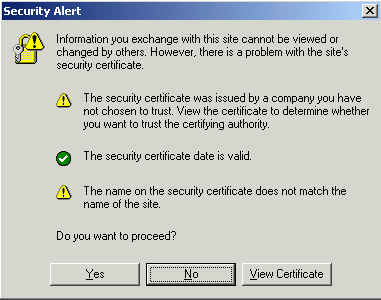
Click View Certificate to display the Certificate dialog.
Display the Details tab.

Click Copy to File to start the Certificate Export Wizard.

Click Next to display the Export File Format page in the Certificate Export Wizard.
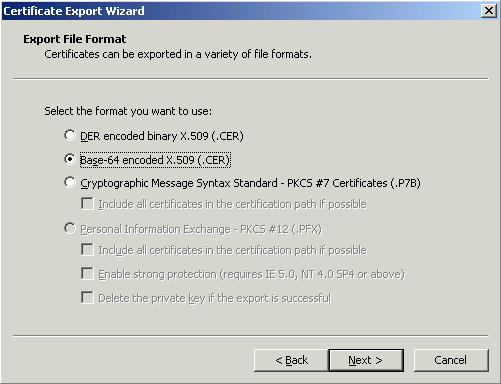
Select the Base-64 encoded X.509 (.CER) radio button.
Click Next to display the File to Export page in the Certificate Export Wizard.
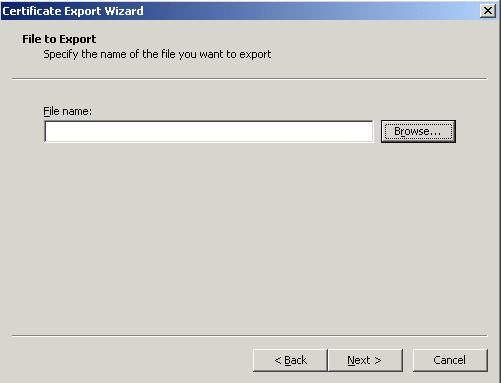
You now choose a temporary name and location for the exported certificate file.
Enter a file location and file name (with a '.cer' extension) for the exported certificate file in the File name field (e.g. c:\tmp\mycertificate.cer).
Click Next to display the final page of the Certificate Export Wizard dialog.
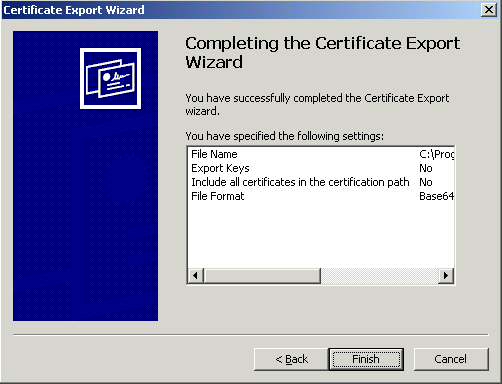
Click Finish to complete the certificate installation.
A confirmation dialog is displayed.
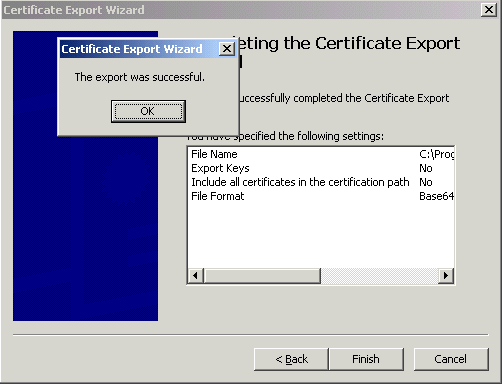
Click OK to close the confirmation dialog and the Certificate Export Wizard and return to the Details tab of the Certificate dialog.
Click OK in the Details tab of the Certificate dialog to return to the Security Alert dialog.

Leave the Security Alert dialog displayed.
Import the security certificate file that you saved earlier into the certificate store of the JVM you are using, as follows:
if you are using JInititator, see Section 3.5.2, "How to import certificate details into the JInitiator certificate store"
if you are using Sun Java Plug-in, see Section 3.5.3, "How to import certificate details into the Java Plug-in certificate store"
(optional) Delete the certificate file that you saved earlier (e.g. c:\tmp\mycertificate.cer).
At the Security Alert dialog, click Yes to accept the security certificate and start Discoverer Plus.
Discoverer Plus starts in HTTPS mode and displays the Connect to OracleBI Discoverer page.

Note: In HTTPS mode, Discoverer Plus displays a padlock symbol on the status bar of the browser, which indicates that the Web session is secure.
Notes
For information about installing security certificates with a JVM other than Java Plug-in, consult the proprietary documentation for that JVM.
If you install a new JVM when you start Discoverer Plus, you must reinstall the Web server's security certificate into the JVM certificate store on all client machines that run Discoverer Plus.
When configuring Discoverer Plus to run over HTTPS using JInitiator, you import the certificate details into the JInitiator certificate store after you have used the Certificate Export Wizard to export a certificate file (for more information, see Section 3.5.1, "How to install a security certificate on a Discoverer Plus client machine").
To import certificate details into the JInitiator certificate store:
Open the certificate file that you saved in Section 3.5.1, "How to install a security certificate on a Discoverer Plus client machine" in a text editor (e.g. c:\tmp\mycertificate.cer).
The screenshot below shows a certificate file called mycertificate.cer opened in a text editor.
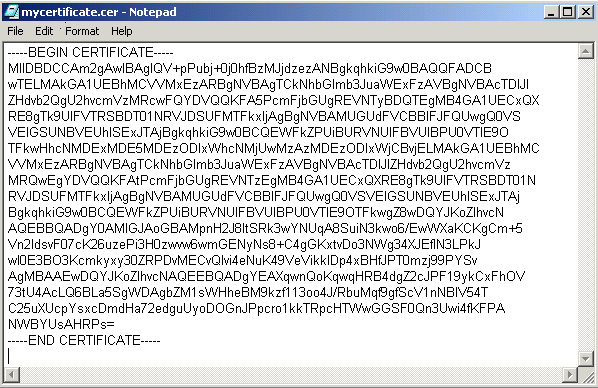
JInitiator's certificate store is contained in a file called certdb.txt.
Open the certdb.txt file in a separate text editor (for more information about the location of configuration files, see Section A.1, "List of Discoverer file locations").
Copy the entire contents (including the '-----BEGIN CERTIFICATE-----' and '-----END CERTIFICATE-----' text) of the certificate file (e.g. c:\tmp\mycertificate.cer) to the end of the certdb.txt file.
Save the certdb.txt file.
When configuring Discoverer Plus to run over HTTPS using Java Plug-in, you import the certificate details into the Java Plug-in certificate store after you have used the Certificate Export Wizard to export a certificate file.
Display the Java Plug-in Control Panel.
For example, on Windows choose Start | Settings | Control Panel to display the Windows Control Panel, then select the Java Plug-in icon.
Display the Certificates tab.

Select the Signed Applet radio button in the Certificates panel (if it is not selected already).
Click Import and import the certificate file that you saved in Section 3.5.1, "How to install a security certificate on a Discoverer Plus client machine" (e.g. c:\tmp\mycertificate.cer).

The security certificate is displayed in the list of certificates in the Java Plug-in certificate store.
Click Apply.
When you start Discoverer Plus for the first time on a client machine, you perform a one-time setup process to install a Java Virtual Machine and initialize the Discoverer Plus software. This process is typically performed when:
you want to test that Discoverer is working
a Discoverer end user wants to start Discoverer Plus for the first time on a client machine
If you upgrade Discoverer, you might have to repeat the setup process. For example, you might install a new version of Discoverer Plus that requires a new version of the Java runtime environment.
OracleBI Discoverer installs either the Sun Java Plug-in (default) or the Oracle JInitiator Plug-in on client browser machines. For more information about changing the Java plug-in that Discoverer uses, see Section 5.9.1, "How to specify a different Java Virtual Machine for Discoverer Plus".
The Discoverer Plus initialization procedure is different for different browsers. Refer to the appropriate task below:
For Microsoft Internet Explorer on a Windows client, see Section 3.8, "How to start Discoverer Plus over HTTP in Microsoft Internet Explorer for the first time on a Windows client machine".
For Netscape Navigator on a Windows client, see Section 3.9, "How to start Discoverer Plus over HTTP in Netscape Navigator for the first time on a Windows client machine".
For Netscape Navigator on a UNIX client, see Section 3.10, "How to start Discoverer Plus over HTTP in Netscape Navigator for the first time on a UNIX client machine".
For Safari on an Apple Mac client, Apple Mac OS X is the minimum required operating system. Apple Mac OS X machines are pre-installed with Java 1.4.2, which includes the Java runtime environment required by Discoverer Plus. Therefore, you can run Discoverer Plus without manually installing a Java runtime environment (for more information, see Section 3.7, "How to start Discoverer Plus").
To check that a client browser machine has the required Java Plug-in, use the Apple Macintosh Software Update option. You should see Java 1.4.2 in the software list on the Software Update dialog (see screenshot below). If Java 1.4.2 is not installed, use the Automatic Update options to install the latest Java Plug-in version.
Figure 3-1 Software Update dialog in Apple Mac OS X

Note: If Discoverer Plus users use Apple Mac OS X client machines, you must specify the Sun Java Plug-in as the Java Virtual Machine on the Discoverer middle tier (for more information about choosing a JVM, see Section 5.9, "About running Discoverer Plus with different Java Virtual Machines").
Notes
If Single Sign-On is enabled, you will first be asked to authenticate as a Single Sign-On user before a Discoverer connections page is displayed.
If Single Sign-On is not enabled, Discoverer end users are asked to enter a database password when they select a private connection.
Note: A Discoverer connection stores login information.
To start Discoverer Plus in Microsoft Internet Explorer, you must have the Security level set no higher than 'Medium' or custom equivalent (i.e. using the Security dialog in Microsoft Internet Explorer).
If a Security Warning dialog is displayed when you start Discoverer, click Yes to install and start the JVM. If you have previously configured the machine to always trust content from Oracle Corporation, this dialog is not displayed.
Note: Discoverer Viewer requires no additional software to be installed on the client machine.
If the Discoverer initialization takes longer than the session timeout (e.g. you might be accessing Discoverer over a 56K dial-up connection), increase the Timeout value in the pref.txt file on the middle tier and apply the preferences. For more information, see Section 10.6, "List of Discoverer user preferences".
You start Discoverer Plus to enable you to manage and edit Discoverer worksheets.
To start Discoverer Plus:
Start a Web browser and enter the Discoverer Plus URL containing the fully qualified host name (including port number if required) used by your own OracleAS installation.
For example:
http://<host.domain>:<port>/discoverer/plus
where:
<host.domain> is the server name and domain on which the Oracle HTTP Server is installed
<port> is the port number (typically 7777) on which Discoverer is installed
For information on finding out the default Discoverer port number, see Section 5.8, "How to list ports used by Oracle Application Server".
/discoverer/plus is the URL command that starts Discoverer Plus
The Connect to OracleBI Discoverer page is displayed.
Figure 3-3 Connect to OracleBI Discoverer page

Note: Connections are only displayed if the Oracle Business Intelligence installation is associated with an OracleAS Infrastructure. If Single Sign-On is enabled, you will first be asked to authenticate as a Single Sign-On user.
Do one of the following:
Select a connection in the Connection column.
Hint: If no connections are displayed in the Connection column, you will have to create a new connection before continuing. For more information about creating private connections, see Oracle Business Intelligence Discoverer Plus User's Guide. You can also use public connections that have been created by the Discoverer manager (for more information, see Section 4.6, "How to create public connections").
Enter login details directly using the Connect Directly area, and click Go.
Discoverer Plus starts (after first installing any required plug-ins).
To start Discoverer Plus in Microsoft Internet Explorer for the first time on a Windows client machine:
Start Discoverer Plus (for more information, see Section 3.7, "How to start Discoverer Plus").
Depending on the software already installed on the client machine, you might have to download and install a Java Virtual Machine (JVM) (e.g. Java Plug-in). If you are not prompted to download and install a JVM, go straight to step 8.
Hint: If the JVM installation process fails, close down extraneous processes on the client machine, then re-try.
If you have to download and install a JVM, the Security Warning dialog is displayed.
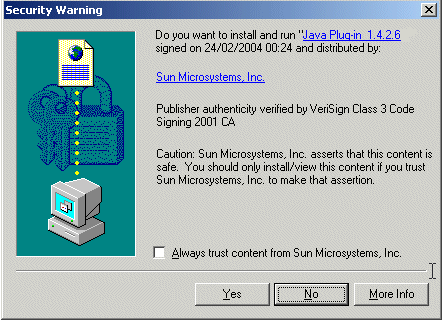
Click Yes to start the plug-in download and display the License Agreement page.
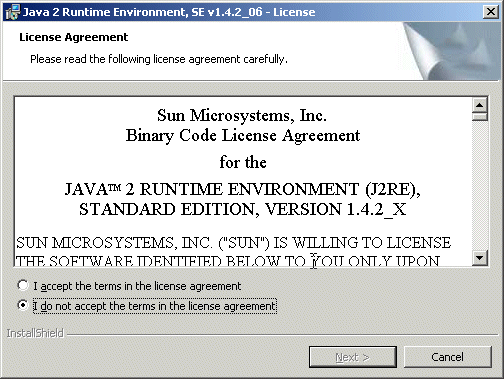
Select the I accept the terms of the license agreement radio button, then click Next to display the Java Runtime Environment - Setup Type dialog.
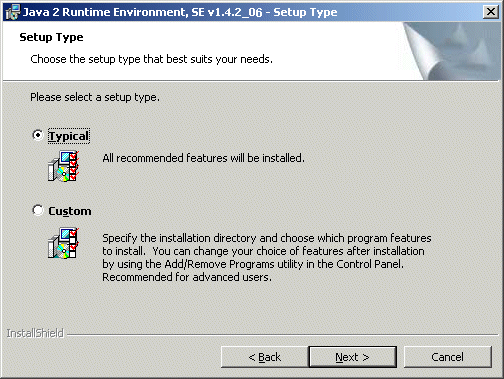
Select the Typical radio button and click Next to start the installation.
When the installation is complete, the Java Runtime Environment - Complete page is displayed.

Click Finish to close the installation wizard.
The Security Warning dialog is displayed.

Click Yes to accept the security certificate and start Discoverer Plus.
Note: If you do not want to display the Warning - Security dialog every time a new Discoverer Plus applet is installed on the client machine, click Always.
The Workbook Wizard dialog is displayed.
Follow the instructions on the Workbook Wizard dialog.

You are now running Discoverer Plus.
To start Discoverer Plus in Netscape Navigator for the first time on a Windows client machine:
Start Discoverer Plus (for more information, see Section 3.7, "How to start Discoverer Plus").
Depending on the software already installed on the client machine, you might have to download and install a Java Virtual Machine (JVM) (e.g. Java Plug-in). If you are not prompted to download and install a JVM, go straight to step 13.
If the client browser machine does not have a JVM installed and you need to install a JVM, Discoverer launches an empty applet browser window.
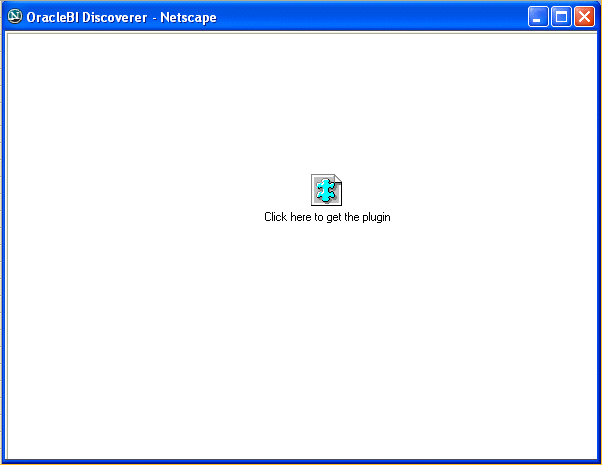
Click anywhere in the empty applet browser window to display the Sun Developer Network download page for JVMs in a separate browser window.

In the browser window containing the Sun Developer Network download page for JVMs, select the Download J2RE link to display the Download page.

Select the Accept License Agreement radio button.
In the Windows Platform area, select the Windows Installation, Multi-language link to display the Opening <JVM file> dialog.
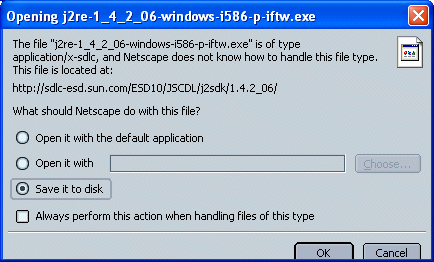
Select the Save it to disk radio button and click OK.
Navigate to a temporary directory on the client browser machine (e.g. d:\temp\) then click Save.
When the file download is complete the Netscape Download Manager dialog is displayed, containing the status of the download.
Close the Netscape Download Manager dialog.
Using a Windows Explorer dialog, navigate to the temporary directory that you selected in step 6 and double click on the downloaded file (e.g. d:\temp\j2re-1_4_2-windows-i586-p-iftw.exe) to start the JVM installation wizard and display the License Agreement page.

Select the I accept the terms of the license agreement check box, then click Next to display the Java Runtime Environment - Setup Type.

Select the Typical radio button and click Next to start the installation.
When the installation is complete, the Java Runtime Environment - Complete page is displayed.

Click anywhere in the empty applet browser window to start Discoverer Plus.
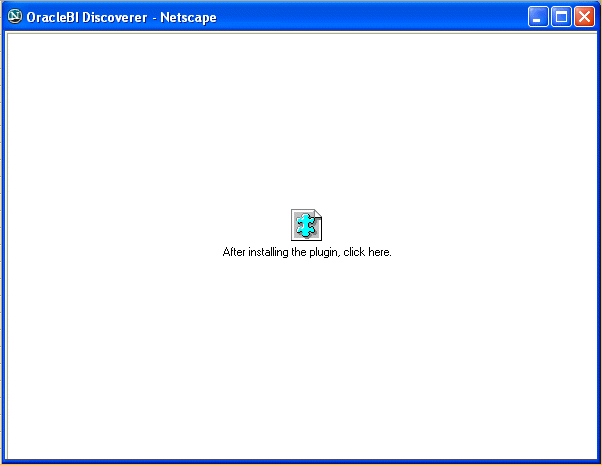
When the Discoverer Plus applet is initialized and cached, the Workbook Wizard dialog is displayed.
Follow the instructions on the Workbook Wizard dialog.

You are now running Discoverer Plus.
To start Discoverer Plus in Netscape Navigator for the first time on a UNIX client machine:
Install a JVM on the client browser machine, as follows:
Start a Web browser and go to the following URL:
http://java.sun.com/products/archive/j2se/1.4.2_06/index.html
Select the DOWNLOAD link in the JRE column for the Download J2SE v 1.4.2_06 option for Windows/Linux/Solaris to display the Download page.
Select the Accept License Agreement radio button.
Select the appropriate Solaris or Linux link to display the Opening <JVM file> dialog.
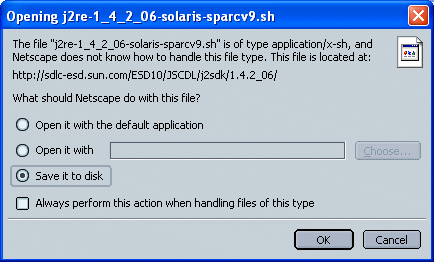
For example, for a Solaris client browser machine, you might select the 64-bit self-extracting file (j2re-1_4_2_06-solaris-sparcv9.sh) link.
Select the Save it to disk radio button and click OK.
Navigate to a temporary directory on the client browser machine (e.g. tmp\) then click Save.
When the file download is complete the Netscape Download Manager dialog is displayed, containing the status of the download.
Close the Netscape Download Manager dialog.
Using a file manager tool, navigate to the temporary directory that you selected in step f and execute the downloaded file (e.g. tmp\j2re-1_4_2_06-solaris-sparcv9.sh) to start the JVM installation wizard and display the License Agreement page.

Follow the instructions in the JVM installation wizard to install the JVM on the client machine.
Start Discoverer Plus (for more information, see Section 3.7, "How to start Discoverer Plus").
Wait for the Discoverer Plus applet to initialize.
While the Discoverer Plus applet initializes, the Starting product: Discoverer Plus page is displayed.
The Discoverer Plus applet is initialized and cached, then the Workbook Wizard dialog is displayed.
You are now running Discoverer Plus.
You might start Discoverer Viewer if you have installed OracleAS and want to test that Discoverer is working.
To start Discoverer Viewer over HTTP:
Start a Web browser and enter the Discoverer Viewer URL containing the fully qualified host name (including port number) used by your own OracleAS installation.
For example:
http://<host.domain>:<port>/discoverer/viewer
where:
<host.domain> is the server name and domain on which the Oracle HTTP Server is installed
<HTTP port> is the port number (typically 7777) on which Discoverer is installed.
For information on finding out the default Discoverer port number, see Section 5.8, "How to list ports used by Oracle Application Server".
/discoverer/viewer is the URL command that starts Discoverer Viewer
The Connect to Discoverer Viewer page is displayed.
Figure 3-4 Connect to Discoverer Viewer page

Note: If Single Sign-On is enabled, you will first be asked to authenticate as a Single Sign-On user.
Do one of the following:
Select a connection in the Connection column.
Hint: If no connections are displayed in the Connection column, you will have to create a new connection before continuing. For more information about creating private connections, see Oracle Business Intelligence Discoverer Viewer User's Guide. You can also use public connections that have been created by the Discoverer manager (for more information, see Section 4.6, "How to create public connections").
Enter login details directly using the Connect Directly area, and click Go.
The Worksheet list page is displayed.
Select a worksheet in the Name column to display the workbook in Discoverer Viewer.
You are now running Discoverer Viewer.
Notes
To start Discoverer Viewer over HTTPS, enter the Discoverer Viewer HTTPS URL (e.g. https://<host.domain>:<HTTPS port>/discoverer/viewer). For more information about running Discoverer Viewer over HTTPS, see Section 3.5, "About running Discoverer over HTTPS".